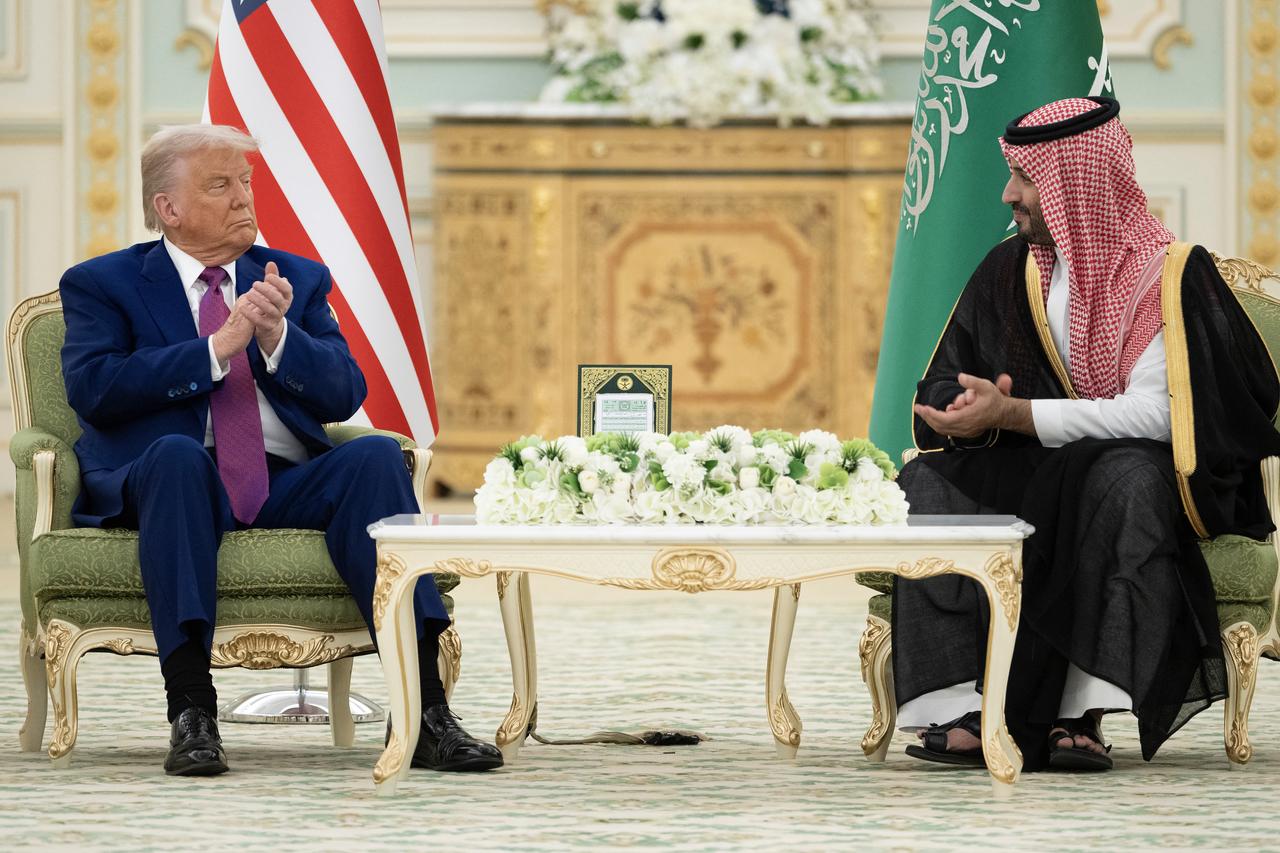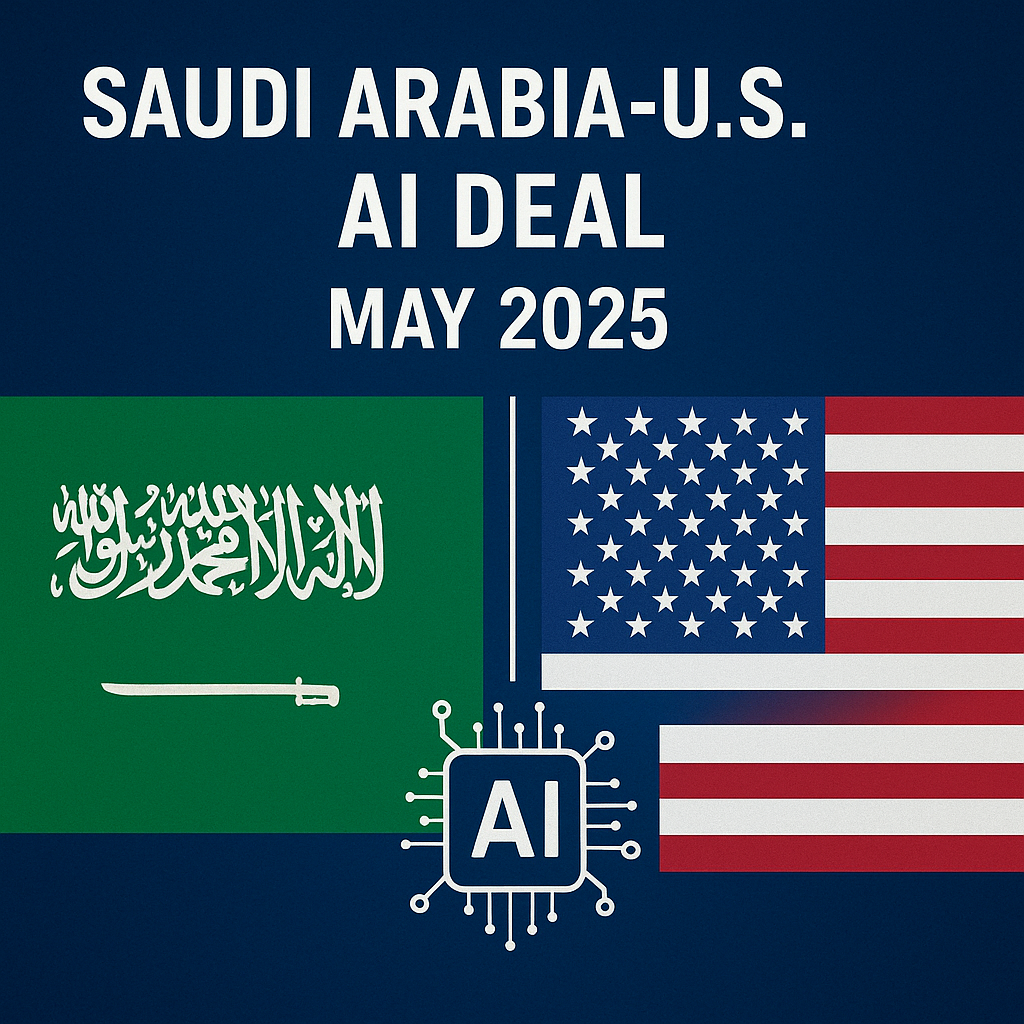Introduction

This chapter provides an overview of the Saudi Arabia-U.S. AI Deal.

The Saudi Arabia-U.S. AI deal, which was concluded during President Donald Trump’s visit to Riyadh on May 13-14, 2025, is a key part of a $600 billion investment package that includes AI, defence, and energy fields (White House Fact Sheet). This historic agreement is a testament to a new age of spurring technology innovation and economic growth between the two countries across the globe.
Key Aspects
AI Infrastructure: Saudi Arabia to invest $20 billion in US AI data centres and power infrastructure (for which US tech firms (Nvidia, AMD, Qualcomm) will provide next-generation AI chips) (Reuters: US Tech Firms)
Human Creation: It involves the creation of Humain, a Saudi AI Company set up by the Saudi Public Investment Fund (PIF) with a mandate to develop AI technologies, including ML Arabic, a multimodal large language model (Reuters: Launch of Humain).
A Strong Bargain Partnership: The Deal enhances the mutual partnership between the two countries. Saudi Arabia invests heavily in various sectors of the American economy, thus promoting and signing agreements that will lead to unprecedented long-term prosperity between the US and Saudi Arabia.
Importance
The agreement is essential for multiple reasons:
It would make Saudi Arabia a possible AI hub for the world, in line with Vision 2030, the government’s plan to build its economy beyond oil.
It strengthens American technological dominance, increasing our economic leverage in the Middle East and our competitiveness with China.
It promotes job growth and technical innovation in both countries; most investments will likely be long-term.
Strategic Intent
This partnership is twofold:
Saudi Arabia: A strategic alignment of AI to stimulate economic diversification, develop a knowledge-based economy, and reduce dependence on oil exports.
United States: To win significant investments, bolster its position in the global AI race, and cement strategic partnerships in the Middle East to counter China’s growing influence. (Bloomberg: AI Chip Access)
A Saudi Vision on AI and Diversified Economy
Vision 2030, introduced in 2016, is a national transformation plan issued for the Kingdom of Saudi Arabia to decrease the nation’s reliance on oil and create a thriving, diversified, forward-looking economy (SDAIA: Vision 2030). AI essentially drives the transformation.
Economic Decode (Economic diversification): AI is one of the main factors helping to create new sectors like healthcare, education, and tourism away from a petrol-dependent economy.
The Road to Global Leadership: Projects like Project Transcendence(Huffington Post Saudi Arabia Dream AI Global ) require a $100 billion AI investment.
SDAIA The Saudi Data and Artificial Intelligence Authority (SDAIA), which was formed in 2019, is tasked with building a responsible AI environment, developing public-private partnerships, and driving AI innovation.
Aspirations in Becoming a World AI Leader
Infrastructure Investment: The country is constructing some of the world’s most advanced AI data centres and working with technology companies from other parts to improve its technology.
Homegrown AI: The emphasis on creating Arabic-tailored AI models, like those made by Humain, that meet regional cultural and linguistic needs will also help establish the Kingdom as the place for AI innovation outside the US.
Talent and Research: The Kingdom also seeks to lure AI talent worldwide, pouring funding into research and development that can rival top tech giants.
Key Players in the Deal
It includes big US tech companies crucial to building Saudi Arabia’s AI infrastructure.
Major U.S. Tech Companies
| Company | Role in the Deal | Contribution |
| Nvidia | Supplying AI chips | Supplying AI chips |
| AMD | AI hardware partnership | Supplying AI chips |
| Qualcomm | Data centre CPU development | Signed a memo of understanding with Humain to develop and build a data centre central processor (CPU). |
| Others (Google, Oracle, Salesforce, Uber) | Transformative tech investments | Part of an $80 billion investment in transformative technologies across both countries. |
Contributions to the AI infrastructure in Saudi Arabia
Nvidia and AMD: Make the computing power required to develop AI available, allowing for the construction of megacenters in Saudi Arabia for deep AI work.
Qualcomm: Boosts Saudi Arabia’s IT prowess with AI datacenter specialised hardware built in-country.
Broader Impact: These firms bring technical capabilities, innovation, and global access to AI ecosystems to help Saudi Arabia realise its AI ambitions faster.
Development of Human and Its Significance
Formation of Human
Crown Prince Mohammad bin Salman announced Humain on May 12, 2025, as a unit to develop and oversee AI in Saudi Arabia (Reuters: Humain Launch). Part of the Public Investment Fund (PIF), Humain is a linchpin of Saudi Arabia’s AI plan.
Goals and Significance
Multimodal Arabic Large Language Model: Humans are integrated with efforts to develop AI models sensitive to local context, culture, and language to respond to the demand for Arabic technologies and systems.
AI Ecosystem Development —Human supports Saudi Arabia’s plan to become the global AI hub by developing data centres, cloud infrastructure, and advanced AI models.
Strategic Boarding: Humain’s founding fits with Vision 2030, boosting the Kingdom’s technology independence and global competitiveness in AI.
Impact on the AI Landscape
Humans’ initiatives will:
Inspire Arabic AI applications to emerge, drive innovation, and shape the global AI landscape.
Boost Saudi Arabia’s standing as a major player in the global AI industry, akin to the US and China.
Generate local capacity and international partnerships.
Technological developments aUSollaboration
Technological Innovations
Sophisticated AI Chips: It has access to Nvidia’s Blackwell chips and AMD hardware (which means Saudi Arabia can construct data centres of up to 500 megawatts) (Reuters: US Tech Firms).
Cloud Infrastructure – Strategic alliances with Google and Oracle bring the IT infrastructure for AI development and deployment.
Joint Research Projects: The agreement features joint work in AI research in areas pushing the frontiers of natural language processing, autonomous systems, and AI ethics.
Strategic Partnerships
US Tech Firms: Partnerships with Nvidia, AMD, Qualcomm, etc., bring state-of-the-art technologies to the
Talent Exchange Programs: Programs aimed at supporting the movement of AI professionals and researchers between the US and Saudi Arabia. These programs aim to support expertise and enhance the relationship between the US and Sau and Saudi Arabi and Saudi Arabia.
Global AI EcoAIstem: The partnerships will contribute to the global AIAIcoAIstem, facilitating collaboration and innovation.
Geopolitical Implications
Impact on the Global AIACE
The agreement bolsters the United States’ role in the Indo-Pacific East against China’s expanding tech footprint (Bloomberg: AI Chip Access). The Deal to arm Saudi Arabia with cutting-edge American technology, USS, USS pre, served the United States’ dominant military position in the global insights race, where China is a primary rival.
Role in U.S.-Saudi Relations
The dealarks an expansion of U.S.-Saudi relations beyond traditional areas of energy and defence into technology and innovation.
It’s all part of the USS strategy to stabilise the Middle East, counter Iran, and improve regional security.
Wider Geopolitical Implications
The pact underscores the region’s growing import competition in AI, as Saudi Arabia and the U.A.E. emerge as major players.
Concerns remain about technology transfers to China because of the Kingdom’s loosening, which raises national security concerns for the US (The US New York Times: Chip Deals).
7. Economic Benefits for Both Countries
Economic Implications of the US (billion Deal
The Dealudes Dealificant investments across multiple sectors, as outlined in the following table:
| Sector | Investment Details | Amount |
| AI AID Energy Infrastructure | U.U.S. Services exports for projects like the King Salman International Airport | $20 billion |
| Transformative Technologies | Investments by Google, DataVolt, Oracle, Salesforce, AMD, and Uber in the US | $80 billion |
| Infrastructure Projects | U.U.S. Services exports for projects like the King Salman International Airport | $2 billion |
| Energy Solutions | Investments by Google, DataVolt, Oracle, Salesforce, AMD, and Uber in the US | $14.2 billion |
| Aircraft Exports | Boeing 737-8 passenger aircraft for AviLease | $4.8 billion |
| Healthcare | Investments, including a plant in Michigan | $5.8 billion |
| Sector-Specific Funds | Energy, aerospace, and sports funds | $14 billion |
| Defense Sales | Investments by Google, DataVolt, Oracle, Salesforce, AMD, and Uber in the US | the billion |
Benefits for Both Countries
United States:
- High-tech and manufacturing job growth.
- Solidified economic relations with a key Asian country in the Indo-Pacific.
- Strengthened global technological supremacy through technological AI and its companions.
Saudi Arabia:
- Companion technology will make Vision 2030 objectives possible and ahead of schedule.
- Economic diversity through the development of new industries and jobs.
- A destination for international investors with global leaders.
Long-Term Growth
The investments will help fuel technological advancement, promote innovation, and create thousands of high-tech jobs, which will help sustain economic growth in both countries.
Challenges and Criticisms
Potential Challenges
AI EAIics and Cybersecurity: There are concerns about what Saudi Arabia might do with a sophisticated AI governance system to address its cybersecurity problems.
Technology Transfer Risks: There are concerns that U.S.-made technology might be shared with third parties, including (in this case) Saudi Arabia (Bloomberg: AI Chip Access).
Human Rights Concerns Saudi Arabia’s human rights record, such as the 2018 brutal killing of journalist Jamal Khashoggi, creates ethical points of concern related to the alliance (Reuters: Trump’s Gulf Visit).
Criticisms
- National Security Risks: The US is apprehensive about the technology with Saudi Arabia, which has historically used it in ways that could be detrimental to the US (US York Chip Deals).
- Economic Dependence: Some critics worry that the US theme uses the question of whether Saudi investments will materialise and become too dependent on Saudi investment.
- Geopolitical Risks: The Deal could strain US dealings with the Middle Eastern powers, especially Iran, and trigger concerns about regional stability.
Balancing Act
Several challenges can be addressed by strengthening Saudi Arabia and the US, addressing ethical challenges in the US, and creating transparency around how technology is used to maintain the international community.
The FAIure of SA in AI
Expansion of AI CapabiAIties
- ProjectAIranscendence: A $100 billion AI investment in invesAIng in AI, and AAIworkAAI workforceng so that Saudi Arabia is one of the top 15 AI countries by 2030 (CAI: AI00 billion).
- Talent Attraction: Strategy to win the world’s top artificial intelligence talent and encourage international companies to base operations in the Kingdom.
- R&Kingdom payments stat applications and applications specially designed for Arabic.
Vision for a Global AI: The AI Report
- According to the AI report, the strategy’s outcomes in AI include stepping out of AI and exporting AI to AI-AI in 2030 to AI-val technology leaders like the US and the US.
- This emphasis on a bic AI is culturally relevant to be a global influence in loading the US.
Implications for the Global USS Army
Saudi Arabia’s investment plots out the investment, potentially setting up a third centre of gravity alongside the USS and China.
Strategic USS partnerships and infrastructure investments in the Kingdom increase the Kingdom’s position.
He added, “Kingdom’s CompaniesKingdom’s long-term success in A.I. will owe a lot of success to going open source in data and training and ultimately employing A.I.”
Conclusion: What ThiAIeal Means for the Future of AI.
The Dealdi Arabia-AI. The Deal is a landmark deal that reinforces economic and technological connections between the two countries. For Saudi Arabia, it entrenches its Vision 2030 objectives faster, aiming to make the Kingdom a global power, a worldwide investment kingdom, and a dominant force in an international race, which is no different from TUSdeal’s USS.
However, the US deal’s impact goes beyond the two countries’ relations, underscoring the Middle East’s increasing stakes in the worldwide race for AIUS. At the same time, it’s also spotlighting pressing issues around AI ethics, cybersecurity, and broader geopolitical risks that must be addressed for the momentum to be sustainable. It will create jobs and drive innovation in fields ranging from health care to aviation, accelerating the development of learning-based technologies.


